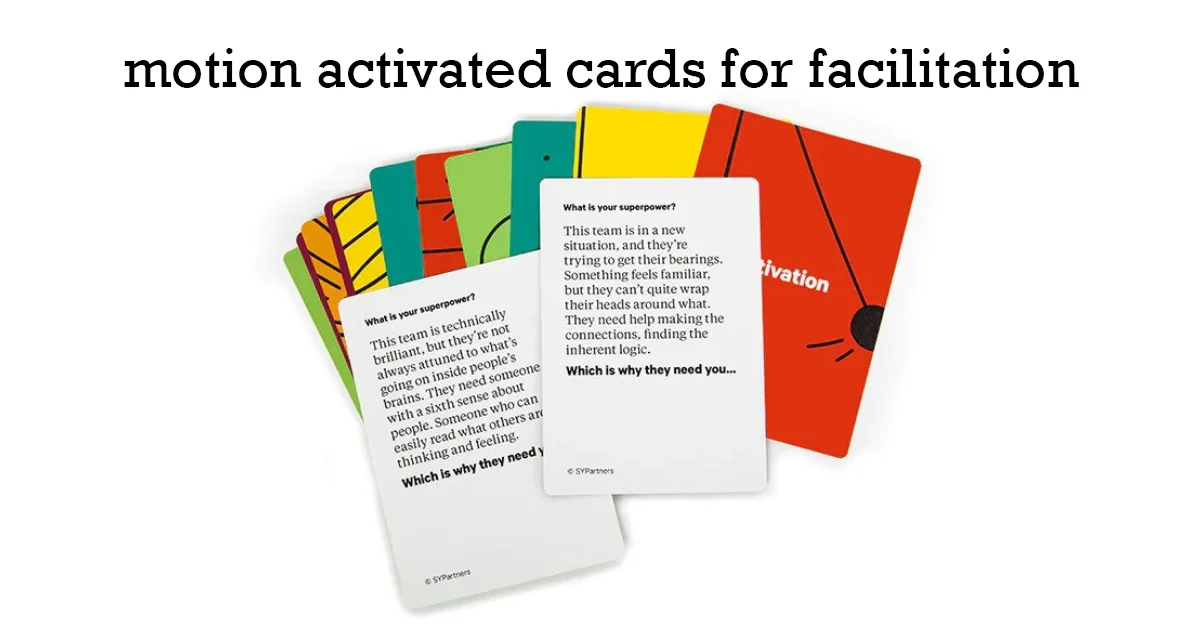In today’s fast-paced digital world, capturing and retaining attention is more challenging than ever. Whether you’re managing a corporate workshop, leading a training session, or facilitating a conference, finding innovative ways to engage your audience is crucial.
One groundbreaking tool that can elevate engagement and create a memorable experience is motion-activated cards. This article explores how these dynamic cards can enhance facilitation, boosting interaction and participation like never before.
What Are Motion-Activated Cards?
Motion-activated cards are interactive tools designed to engage users through physical movement. Unlike traditional static cards, these cards respond to motion, making them an exciting addition to various facilitation settings. By incorporating sensors and advanced technology, these cards activate specific responses or animations when triggered by movement, creating an interactive experience that captivates participants.
How Do Motion-Activated Cards Work?
Motion-activated cards are equipped with sensors that detect physical movement or gestures. When a user interacts with the card—by flipping, turning, or moving it—a sensor activates, triggering a predefined response. This response can vary from visual animations and audio cues to digital interactions. The technology behind these cards often includes:
- Accelerometers: Sensors that measure acceleration and movement.
- Gyroscopes: Devices that detect orientation and rotational movement.
- Microcontrollers: Processing units that handle the card’s response based on sensor input.
These components work together to create a seamless and engaging experience, enhancing the overall effectiveness of facilitation activities.
Benefits of Motion-Activated Cards for Facilitation
Incorporating motion-activated cards into your facilitation strategy offers several key benefits:
Enhanced Engagement
Motion-activated cards capture attention through dynamic interaction, making sessions more engaging. The novelty of movement-triggered responses keeps participants intrigued and motivated to interact with the cards, leading to higher levels of engagement and participation.
Increased Interactivity
These cards promote hands-on involvement, allowing participants to physically interact with the content. This tactile engagement can improve comprehension and retention, as users are actively involved in the learning process rather than passively observing.
Stimulated Creativity
The interactive nature of motion-activated cards can stimulate creative thinking. By integrating these cards into brainstorming sessions or problem-solving activities, facilitators can encourage participants to think outside the box and explore new ideas through physical manipulation.
Immediate Feedback
Motion-activated cards provide instant feedback based on user interactions. This immediate response can be particularly useful in training and educational environments, where timely feedback helps reinforce learning and correct misunderstandings on the spot.
Versatility in Applications
These cards can be adapted for various purposes, including team-building exercises, educational games, and interactive presentations. Their versatility allows facilitators to customize the cards for different contexts and objectives, making them a valuable tool in diverse settings.
Applications of Motion-Activated Cards
Motion-activated cards can be used in a variety of facilitation scenarios to enhance engagement and effectiveness:
Corporate Workshops
In corporate workshops, motion-activated cards can be used to facilitate team-building exercises, role-playing activities, and interactive discussions. The cards can trigger scenarios, case studies, or feedback based on participants’ actions, making the workshop more dynamic and participatory.
Educational Training
For educational purposes, motion-activated cards can serve as interactive learning aids. Teachers and trainers can use them to present information, quiz participants, or simulate real-world scenarios. The cards’ immediate responses can help reinforce key concepts and maintain student interest.
Conferences and Seminars
During conferences and seminars, motion-activated cards can be integrated into presentations to make them more interactive. They can be used to engage the audience in Q&A sessions, conduct live polls, or facilitate interactive demonstrations, making the event more engaging and memorable.
Product Launches
In product launches, motion-activated cards can create a memorable experience for attendees. They can be used to reveal product features, provide interactive demos, or gather feedback in an engaging way. The novelty of the cards can enhance the overall impact of the launch event.
Implementing Motion-Activated Cards in Your Facilitation Strategy
To effectively incorporate motion-activated cards into your facilitation strategy, consider the following steps:
Define Objectives
Identify the goals you want to achieve with the motion-activated cards. Whether it’s increasing engagement, enhancing interactivity, or providing immediate feedback, having clear objectives will help you design and implement the cards effectively.
Customize Card Content
Tailor the content and responses of the motion-activated cards to align with your facilitation objectives. This could include designing animations, audio cues, or interactive elements that support your specific activities and themes.
Test and Refine
Before using the cards in a live setting, conduct thorough testing to ensure they function as intended. Gather feedback from a small group of users to identify any issues or areas for improvement. Refine the cards based on this feedback to ensure optimal performance.
Integrate with Other Tools
Combine motion-activated cards with other facilitation tools and techniques to create a comprehensive engagement strategy. For example, use them alongside digital presentations, group discussions, or interactive whiteboards to enhance overall effectiveness.
Train Facilitators
Ensure that facilitators are trained in using the motion-activated cards effectively. Provide guidance on how to integrate the cards into their sessions, troubleshoot any issues, and maximize their impact on engagement and participation.
Conclusion
Motion-activated cards offer a revolutionary way to boost engagement and interactivity in facilitation settings. By leveraging the power of movement-triggered responses, facilitators can create dynamic, hands-on experiences that captivate participants and enhance learning outcomes. Whether used in corporate workshops, educational training, conferences, or product launches, these cards provide a versatile and innovative tool for achieving your facilitation goals.
As technology continues to evolve, integrating motion-activated cards into your facilitation strategy can set you apart and deliver memorable experiences that resonate with your audience. Embrace the future of engagement with motion-activated cards and watch as your facilitation efforts reach new heights of success.
ALSO READ: Discover Zooskooñ: A Unique Experience In Wildlife Conservation

